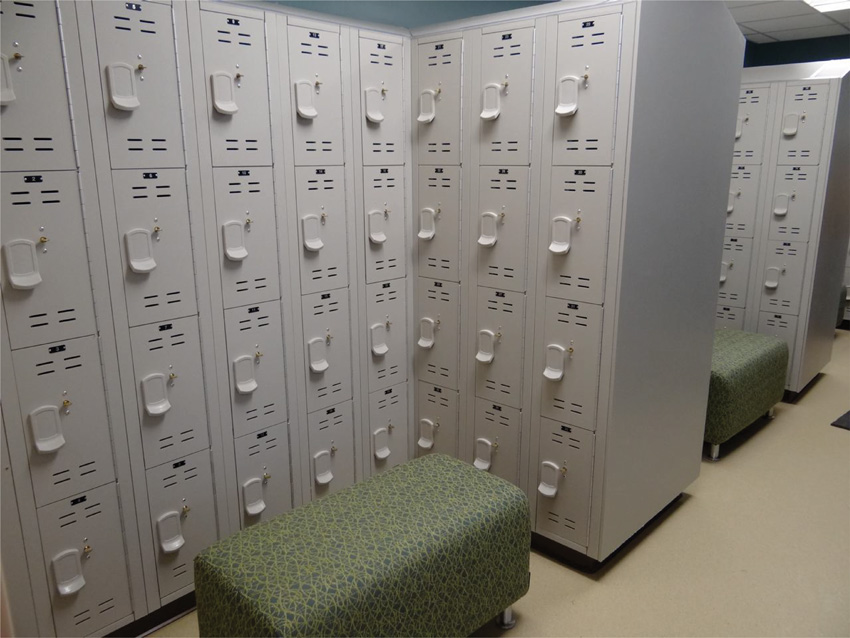The Renaissance of the Restroom
Lockers at the University Hospital of Missouri
A $190-million patient care tower was recently added to the University Hospital in Columbia, Missouri, that would enhance the outcomes of the thousands of cancer patients treated there annually. With 90 private rooms equipped with smart technology, six operating rooms, a healing garden, a 7,000-square-foot inpatient pharmacy, 10,000 square feet of green roofs, and a 100,000-square-foot cancer center, the eight-story addition seeking LEED Silver certification was specifically developed to blend the latest health-care delivery methods with relaxation and environmentalism.

Photo courtesy of Scranton Products®
The new patient care tower at the University Hospital of Missouri features nearly 700 lockers made from solid HDPE for use across the new medical facility and its 10 different locker rooms.
The Sustainable and Sanitary Locker Solution
Designers needed to select nearly 700 lockers for use across the new medical facility, including its 10 different locker rooms. The solid HDPE lockers they chose contributed toward LEED credits for the project and were perfectly suited for the health-care environment in terms of the low volatile organic compound (VOC) emissions levels and resistance to rust, bacteria, germs, and mildew.
LEED v4 Credit Contribution
Solid HDPE lockers can contribute toward several of the LEED v4 credits in the Material and Resources (MR) and Indoor Air Quality (IAQ) categories. The material contains recycled content, is recyclable, is GREENGUARD Gold certified, and is recognized as a low-emitting material.
Contains Recycled Content
The HDPE lockers are made from recycled materials and contain both pre- and post-consumer content. They are available in 100 percent post-consumer material. The recycled content of these lockers can contribute toward earning LEED v4 credits. For example, according to the LEED v4 standard, products meeting recycled content criteria are valued at 100 percent of their cost for the purposes of the credit achievement calculation. This means that HDPE lockers can contribute toward meeting the necessary cost thresholds as required in the Building Product Disclosure and Optimization: Sourcing of Raw Materials credit.
“The recycled content in these lockers made them the ideal choice for the tower’s ecofriendly design and mission to capture LEED certification status,” explains Matt Hackbarth of HOK, the global firm responsible for the design, architecture, engineering, and planning of the University Hospital patient care tower.
100 Percent Recyclable
The lockers made from solid HDPE are also 100 percent recyclable. In fact, HDPE is one of the few materials that can be recycled in its current form. When the lockers are taken down, they can be returned to the manufacturing facility, ground up, and put back into the manufacturing process. HDPE does not lose any of its chemical composition during the recycling process so a locker made with recycled bits will retain the durability, moisture resistance, and antimicrobial properties of the original product.
GREENGUARD Gold Certified
HDPE lockers are GREENGUARD Gold certified, which means they meet strict certification requirements and standards for low emissions of VOCs into the indoor air. The GREENGUARD Gold standard includes health-based criteria that considers chemicals not included in the basic GREENGUARD certification and requires lower total VOC emissions levels. Satisfying these important safety guidelines also indicates that the product is fit for use in health-care facilities, where occupants or patients may be especially sensitive to VOCs.
Low VOC Emissions
The solid HDPE material is formulated from a homogenous color-throughout compound, which means that the lockers will never need to be painted to restore the brilliance of their color. Nor will the color flake or peel or be compromised if the surface is scratched. The solid pieces of HDPE used to construct the lockers retain the color of the product throughout each panel. While there are many time-saving maintenance benefits to selecting nearly 700 lockers that will never need to be painted, there are sustainable benefits as well. The elimination of paint on the product also contributes toward the product being able to satisfy those low VOC emissions standards.

Photo courtesy of Scranton Products®
The solid HDPE lockers selected for this project contributed toward earning several LEED v4 credits because the material contains recycled content, is recyclable, is GREENGUARD Gold certified, and is recognized as a low-emitting material.
Sanitary
HDPE lockers are a natural fit for the health-care space. They are resistant to bacteria, mildew, and mold so nothing will grow inside or outside of the lockers, a characteristic that also helps to protect the integrity of the indoor air quality. Solid HDPE is also naturally germ resistant. Testing conducted by SITU Biosciences, employing the ISO 22196 methods, included a study that explored the ability of MRSA (Methicillin-resistant Staphylococcus aureus) bacteria to live on the HDPE surface. The study found that, after 24 hours, 98.4 percent of the MRSA bacteria had died off the surface of HDPE plastic without the use of any cleaning solutions.
Notice

www.americanspecialties.com










